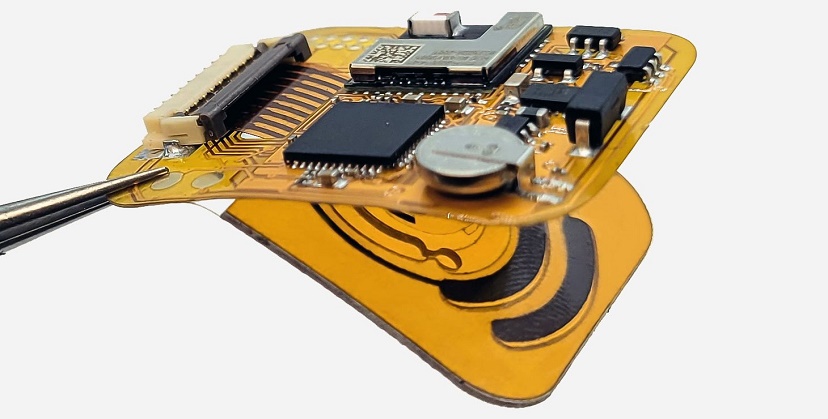
The vast majority of diseases and disorders afflicting humans, ranging from arthritis to Zika fever, involve some level of inflammation. While inflammation is most familiar to us as pain, redness, and swelling, a slew of biochemical markers is associated with it as well.
One of these markers, the C-reactive protein, or CRP, which is secreted by the liver, is so commonly associated with inflammation that its presence in the bloodstream is a strong indicator of an underlying health condition.
Now, researchers at Caltech have developed a first-of-its-kind wearable skin sensor that can wirelessly detect the presence of CRP in human sweat. This sensor will make it easier for patients and medical professionals to monitor their health without the need for more invasive blood tests.
Wei Gao, whose lab is responsible for the development of a variety of wearable sweat sensors, including this latest one, says CRP is much more difficult to detect than the molecules detected by his other sweat sensors. One reason is that CRP is present in the blood at a much lower concentration than other biomarkers. This is largely because CRP molecules are much larger than other biomarker molecules, which means it is a lot more difficult for them to be secreted from the bloodstream into sweat. Another reason is that sensitive CRP detection usually requires special laboratory steps that wash samples to ensure consistent sensing.

“Those were the main issues that prevented people from doing wearable CRP sensing before,” says Gao, assistant professor of medical engineering, Heritage Medical Research Institute Investigator, and Ronald and JoAnne Willens Scholar. “We need high sensitivity to monitor very low-concentration CRP automatically on the skin.”
This CRP sensor, like other sensors developed by Gao and his team, is built upon laser-engraved graphene, a sheet-like form of carbon. The graphene structure contains many tiny pores that create a large amount of surface area. Those pores are embedded with antibodies that bind to CRP and special molecules (redox molecules) capable of generating a small electric current under certain conditions.
The sensor also contains gold nanoparticles that carry with them a separate set of CRP antibodies (detector antibodies).
When CRP molecules enter the sensor via sweat, they attach to both the detector antibodies on the gold nanoparticles and the antibodies on the graphene, temporarily gluing the nanoparticles to the graphene and triggering the redox molecule to generate an electrical current that can be measured by electronic components attached to the sensor.
Because each gold nanoparticle contains multiple detector antibodies, they amplify the minuscule signal that a single CRP molecule would otherwise provide, Gao says.
To account for the influence of variations in sweat compositions from person to person on the electrochemical signal of the biosensor, the sensor was also designed to measure the concentration of ions in the sweat, the sweat’s pH, and skin temperature.
Gao says that the work demonstrates for the first time that sweat CRP can be detected accurately and has good correlation with its counterpart in blood, which has implications for his work in the lab and for practical medical applications.
“This is a general platform that lets us monitor extremely low-level molecules in our body fluids. We hope to expand this platform to monitor other clinically relevant protein and hormone molecules,” he says. “We also want to see if this can be used for chronic disease management. Inflammation means a risk for many patients. If they could be monitored at home, their risk can be identified, and they can be given timely treatment.”
The paper describing the work, “A wireless patch for the monitoring of C-reactive protein in sweat,” appears in the June 22 issue of the journal Nature Biomedical Engineering. Co-authors are medical engineering graduate students Jiaobing Tu (MS ’20), Jihong Min (MS ’19), Changhao Xu (MS ’20), and Jiahong Li; postdoctoral scholar research associates in medical engineering Yu Song and Elham Davoodi; staff scientist Ting-Yu Wang and Tsui-Fen Chou, research professor of biology and biological engineering, all of Caltech; Jeff Moore and Harry B. Rossiter of the Lundquist Institute for Biomedical Innovation at Harbor-UCLA Medical Center; Justin Hanson, Erin Hu, and Jeffrey J. Hsu of UCLA; and Tanyalak Parimon and Peter Chen of the Women’s Guild Lung Institute at Cedars-Sinai Medical Center.
Funding for the research was provided by the American Heart Association, the National Institutes of Health, the National Science Foundation, the Office of Naval Research, the Tobacco-Related Disease Research Program, a Sloan Research Fellowship, and the Technology Ventures Internal Project Fund at Cedars-Sinai.
